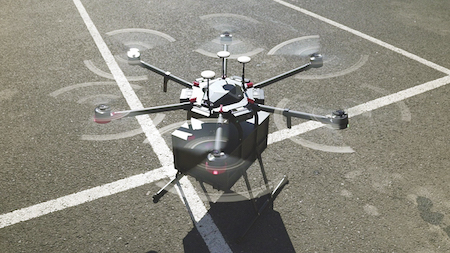This partnership will see products taken from AHA’s Reykjavik headquarters on a two mile journey across to its destination in the first phase of the project. It has been described as the world’s first on-demand urban drone delivery service. Maron Kristófersson, CEO of AHA, speaks to the Robotics Law Journal about the new partnership.
AHA
“AHA is a multi merchant marketplace offering everything from retail items to hot food and groceries delivered instantly, or at an accurate time convenient to you within the next seven days,” says Maron. “We work directly with existing retailers, restaurants and grocery stores to bring their businesses online.”
Aha operates this platform in Iceland in two ways: on the retail market under the website aha.is; and on the wholesale market, under the website distro.is. “We are also offering the platform and our experience as a white-label solution to shopping centre property groups internationally,” says Maron.
Testing out deliveries by drone in Reykjavik gives the company the practice and the ability to offer new skills and services for their platform. Maron: “We aim to be experts on drone deliveries and utilize this experience for our international clients.”
Delivery by Drone
Reykjavik has a large bay, resulting in lengthy deliveries driving around it. The move towards drones comes from the desire to instead just go straight over and across the bay. At present the airborne delivery service is working on this one route, while obtaining licenses for other routes is a current project for expansion of the service.

Cutting down travel time: the UAV route vs. the autombile route
Not that AHA has completely discounted other means. “We have looked at ground robotics as well, in the future the solution is going to be mixed,” says Maron. “Drones have flexibility elements not to be found elsewhere, the sky is everywhere, while ground robots might be needed to carry out the last 200-300 meters in some cases.” For the moment, the focus will be on the remote fliers, with the speed and convenience that they offer that no other technology can quite provide.
There are, of course, the physical challenges of flying drones out in the real world, namely the weather and climate conditions. This is particularly relevant in the windy and snowy conditions of Iceland. “Currently we fly in weather up to 4 m/s wind, and not during rain or snow. However, new drones are appearing in the market that fulfil our requirements and can handle both rain and snow, we are following this technology very carefully.”
To begin with, these deliveries are limited to seasons. They have two weather stations installed, which provide updates on conditions to the second. Aha has also acquired backlog of eleven years of weather data, down to the hour, for extensive analysis to assist with the planning that is required with this new service, and for extending the seasonality. “If we can make sure the drones can land at 9m/s and fly in rainy and snowy weather, we can fly close to 90% of the year,” says Maron. Less than 50% of the year has an average windspeed of 4 m/s or below. If 9 m/s can be safely flown in, it opens up a wealth of new opportunities and up to 90% of the year becomes available for flying.
Beyond the weather conditions, the challenges, according to Maron, are less technical and more related to the business processes related to the drone delivery. “Currently we have one route across the bay to deliver to one point. This we do while we are building public perception and understanding of the service. The scenario where you wake up one morning to drones flying over your house with no previous drone exposure in the area is not likely to happen anywhere, the public must be educated about the service gradually.”
Plans for the future centre around upgrading the UAV technology – in order to combat the weather conditions to open up the active working season and also to increase the payload and distances that they can be carried.
Partnership With Flytrex
The new delivery service is powered by drones provided by Tel-Aviv based company Flytrex, who have moved on from their initial “black box” production lines and are one of the leaders of drone deliveries. “We reached out to all parties who were public about their intentions for automated drone deliveries,” says Maron. But it was the ability of a drone company to deliver BVLoS (Beyond Visual Line of Sight) flights and to provide a viable plan of approach for a commercial operation that drove the partnership with Flytrex. “We quickly reached a level of co-operation with Flytrex where it was obvious we both had a pragmatic approach to the problem which increased the likelihood of success greatly.”

Regulation
It wasn’t an easy process to get the service covered legally. Special permissions to fly BVLoS had to be obtained, as well as to have a drone above the limits and for it be autonomous. This required exemptions from many parts of the regulation in Iceland.
Initially, the request for these exemptions was met with a clear denial from Icetra, the Icelandic Transport Authority. “But the authorities were very professional in articulating the reasons for the denial so we reapplied based on those comments,” says Maron. What followed was an exercise of reapplication, with revisions, to make sure that the new delivery service would be fully compliant with the regulation in Iceland, which is still very much in a formative stage.
In the end, approval had to come from a number of sources. “We had to get written approval from the aviation authority, the city, the police, the ministry and the aviation operator and then our neighbours.” While overcoming all the regulatory hurdles was a lengthy process, Maron considers it to have been educational and that all parties were able to learn a lot from it.


.jpg)
.jpg)
.jpg)

.jpg)




.jpg)